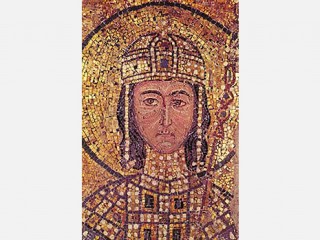
Alexius I biography
Date of birth : -
Date of death : -
Birthplace : Ancient Greece
Nationality : Greek
Category : Historian personalities
Last modified : 2010-11-20
Credited as : Byzantine emperor, Crusades to the Nicaea,
Alexius I (ca. 1048-1118) was Byzantine emperor from 1081 to 1118. He saved the empire from almost certain disaster and led it through the first encounter with the Crusades.
Nephew of the emperor Isaac I Comnenus (reigned 1057-1059), Alexius was raised by his strong willed mother, Anna Dalassena. Even as a youth, he was noted for his great military successes. Surviving shifts in regime, Alexius became the strong right arm of successive emperors and put down a number of rebellions. Driven to revolt himself, he secured the support of other aristocratic leaders and was proclaimed emperor on April 4, 1081.
When Alexius assumed power, the empire seemed about to collapse. Internal affairs were in chaos, and external enemies closed on all sides for the kill. Asia Minor, the empire's former heartland and chief source of manpower and revenue, was all but lost since the disastrous Battle of Manzikert (1071) had exposed it to devastation and occupation by the Seljuk Turks. To the north, the Asiatic Patzinaks (Petchenegs) menaced the Balkan frontiers. And Robert Guiscard, the Norman bandit chieftain who had forged a powerful state in southern Italy, was preparing to attack the empire in quest of a great Eastern realm of his own.
Alexius had little with which to work. He accepted humiliating terms with the Turks, scraped together hasty forces, and purchased naval aid from Venice to face the urgent Norman threat. The Normans were repulsed, and Alexius devoted the next years to freeing the Balkan provinces from combined menaces of a Bulgarian revolt and of invasions by the Patzinaks and another Asiatic tribe, the Cumans. Despite defeats, Alexius played them off against each other, and with Cuman help he defeated the Patzinaks crushingly at Levurnion in 1091. This victory, a turning point in Alexius's struggles, enabled him to consolidate his grasp on the throne.
Alexius turned next to the grim situation in Asia Minor. He realized his need for greater military strength, and at the same time he was anxious to cooperate with the papacy in ending the schism of 1054 between the Eastern and Western Churches. He therefore sent appeals to the Pope and others, urging Westerners to help him fight in the East. Prompted also by other, specifically Western motivations, the Latin response was the First Crusade. Desiring mercenary auxiliaries, the Byzantines were faced instead by a massive outpouring of uncontrolled and irresponsible military adventurers. The initial rabble, under Peter the Hermit, arrived in early 1096 and crossed precipitously to Asia to be massacred by the Turks. The main Crusader army arrived during the following winter.
In June 1097 the Crusaders and Byzantines jointly took Nicaea from the Turks. But ill feelings grew between them, and the Crusaders plunged on their own across Asia Minor toward Syria. The Emperor's failure to aid them in their siege of Antioch in 1097-1098 completed their estrangement. Alexius, however, remained determined to assert his rights of suzerainty over the principalities which the Crusaders established in the Holy Land after their conquest of Jerusalem in 1099. Meanwhile, Bohemund, Guiscard's ambitious son, seized Antioch for himself and returned to Italy to organize a new invasion of the Balkans. In the fighting that ensued from 1104 to 1108, Alexius beat Bohemund to a standstill and brought him to terms. But Bohemund's death in 1111 left the question of Alexius's claims to Antioch and to other Crusader territories unsettled, a problem which would be unraveled by later Byzantine emperors. In the closing decade of his life, Alexius renewed campaigns against the Seljuks, and a victory in 1117 won back for the empire at least some areas of Asia Minor.
The keynotes of Alexius's internal policies were the careful husbanding of limited resources and the astute conversion of liabilities into strengths. The realm he left behind was no longer the greatest power in Christendom, as it had been a century earlier, but it was on its way to a genuine recovery. Before Alexius died on Aug. 16, 1118, he was able to make a clear transfer of power to his son, John II Comnenus, who was to prove perhaps the most noble and admirable sovereign of the entire dynasty.
Alexius is the idealized subject of a biographical history by his daughter, Anna Comnena, The Alexiad of the Princess Anna Comnena (trans. 1928). The chief scholarly study of Alexius is in French: F. Chalandon, Essai sur le r'ne d'Alexis I Comm'e (1900). Chalandon's views are abridged and translated in his account in The Cambridge Medieval History, vol. 4, edited by H. M. Gwatkin (1923). For background information see G. Ostrogorsky, History of the Byzantine State (1940; trans. 1956; rev. ed. 1969), and The Cambridge Medieval History, vol. 4 (2d ed. 1966), part 1, edited by J. M. Hussey.
Comnena, Anna, The Alexiad of the Princess Anna Comnena: being the history of the reign of her father, Alexius I, Emperor of the Romans, 1081-1118 A.D., New York: AMS Press, 1978.
















